人教版初中英语八年级下册Unit_7_Reading公开课教案
人教英语八年级下册Unit7SectionB阅读课教学设计

本章节的教学设计旨在使学生在掌握英语知识的基础上,提高阅读能力、思维能力和语言实践能力。通过本节课的学习,使学生能够更好地理解英语文章,运用所学知识进行有效沟通,并在实际生活中运用所学,为今后的学习源自发展奠定基础。二、学情分析
八年级下册的学生已经具备了一定的英语基础,他们已经掌握了基本的语法知识、词汇量和阅读技巧。在此基础上,他们对英语阅读课有着较高的期待,希望通过阅读提高自己的英语水平。然而,学生在阅读过程中仍存在以下问题:1.阅读速度较慢,对长篇文章容易产生畏惧感;2.缺乏有效的阅读策略,难以快速捕捉文章主旨和细节信息;3.语言表达和思维拓展能力有待提高。
难点:培养学生的高级思维能力,如分析、评价和创造,以及如何将这些能力体现在口头和书面表达中。
(二)教学设想
1.采用多元化教学手段,如多媒体展示、小组合作、角色扮演等,激发学生的学习兴趣和参与热情。
设想:通过观看相关视频和图片,让学生在视觉和听觉上更直观地理解文章内容;小组合作活动可以促进学生之间的互动交流,提高课堂氛围。
2.教师巡回指导,关注每个小组的讨论情况,给予适时指导和鼓励。
-巡回指导:教师关注每个小组的讨论进度,解答学生的疑问。
-鼓励发言:教师鼓励学生积极发言,尊重他人的观点。
(四)课堂练习(500字)
1.教师设计课堂练习,巩固所学知识,提高学生的实际应用能力。
-阅读理解题:设计相关阅读理解题,检验学生对文章内容的掌握。
4.教学评价多样化,注重过程性评价和终结性评价相结合。
设想:通过课堂观察、小组讨论、口头报告和写作任务等多种方式,全面评估学生的学习效果。同时,鼓励学生进行自我评价和同伴评价,提高他们的自主学习能力。
八下英语unit7阅读教学设计

八下英语unit7阅读教学设计Unit 7 Reading Lesson Plan for Eighth Grade EnglishI. IntroductionIn this lesson plan, we will focus on teaching reading skills to eighth-grade students using Unit 7 of the English textbook. The objective is to improve their comprehension, vocabulary, and critical thinking abilities through various activities and exercises.II. Learning Objectives1. Develop reading comprehension skills2. Expand vocabulary related to the unit's topic3. Enhance critical thinking through analyzing text4. Practice reading strategies such as skimming and scanningIII. Pre-Reading Activity: Vocabulary BuildingTo activate students' prior knowledge and expand their vocabulary related to the unit's topic, a word association activity can be conducted. Provide students with a list of key words or concepts from the reading passage and ask them to brainstorm related words. Encourage discussion and teamwork.IV. Reading Activity: Text Analysis1. Pre-Reading Questions:Before diving into the reading passage, ask students thought-provoking questions to stimulate their interest and activate their background knowledge about the topic. This can be done through a class discussion.2. Skimming:In this phase, students quickly read the passage to get a general idea of the content. Emphasize that they should focus on headings, subheadings, and the first and last sentences of each paragraph. Prompt them to identify the main idea and any supporting details through a class discussion.3. Scanning:Provide specific questions related to the passage that require students to search for particular information. This activity helps students practice reading for specific details. Students can work individually or in pairs to find answers to the questions.4. Reading for Detail:In this stage, students read the passage carefully to fully understand the content. Encourage them to annotate the text, underline important points, and make notes in the margins if necessary. Additionally, students can discuss their understanding with peers to clarify any ambiguities.V. Post-Reading Activity: Comprehension Exercises1. Comprehension Questions:Students are given a set of comprehension questions related to the reading passage. These questions assess their understanding of the mainideas, supporting details, and inferential comprehension. Students can work individually or in small groups to discuss and answer the questions.2. Vocabulary Expansion:Direct students' attention to new or challenging vocabulary encountered in the reading passage. Provide exercises or activities that allow them to practice using these words in context or related scenarios. This can involve matching definitions, creating sentences, or engaging in short conversations.3. Critical Thinking:Engage students in critical thinking activities that require them to analyze and evaluate the content they have read. For example, they can be asked to identify the author's purpose, discuss the reliability of the information, or present alternative viewpoints. Encourage open-ended discussions and debates.VI. ConclusionBy incorporating pre-reading, during-reading, and post-reading activities, this lesson aims to improve students' reading comprehension abilities. The various exercises and tasks encourage active participation, critical thinking, and vocabulary expansion. Regular practice and exposure to diverse reading materials will contribute to the overall development of students' English language skills.。
八下Unit7 SectionB reading
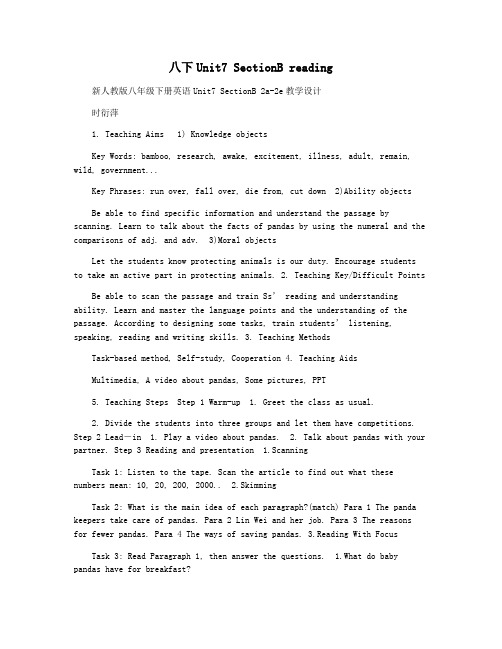
八下Unit7 SectionB reading新人教版八年级下册英语Unit7 SectionB 2a-2e教学设计时衍萍1. Teaching Aims 1) Knowledge objectsKey Words: bamboo, research, awake, excitement, illness, adult, remain, wild, government...Key Phrases: run over, fall over, die from, cut down 2)Ability objectsBe able to find specific information and understand the passage by scanning. Learn to talk about the facts of pandas by using the numeral and the comparisons of adj. and adv. 3)Moral objectsLet the students know protecting animals is our duty. Encourage students to take an active part in protecting animals. 2. Teaching Key/Difficult PointsBe able to scan the passage and train Ss’ reading and understanding ability. Learn and master the language points and the understanding of the passage. According to designing some tasks, train students’ listening, speaking, reading and writing skills. 3. Teaching MethodsTask-based method, Self-study, Cooperation 4. Teaching AidsMultimedia, A video about pandas, Some pictures, PPT5. Teaching Steps Step 1 Warm-up 1. Greet the class as usual.2. Divide the students into three groups and let them have competitions. Step 2 Lead-in 1. Play a video about pandas. 2. Talk about pandas with your partner. Step 3 Reading and presentation 1.ScanningTask 1: Listen to the tape. Scan the article to find out what these numbers mean: 10, 20, 200, 2000.. 2.SkimmingTask 2: What is the main idea of each paragraph?(match) Para 1 The panda keepers take care of pandas. Para 2 Lin Wei and her job. Para 3 The reasonsfor fewer pandas. Para 4 The ways of saving pandas. 3.Reading With FocusTask 3: Read Paragraph 1, then answer the questions. 1.What do baby pandas have for breakfast?2.How do the baby pandas feel when they see the keepers ?Task 4: Read Paragraph 2, then answer the questions. 1.What is Lin Wei’s job? 2.What does she think of pandas ?Task 5: Read Paragraph 3, then fill in the chart.Who Pandas Baby pandas Humans Reasons Task 6: Read Paragraph 4,tell true or false.1. An education program in Chongqing teaches children about pandas andother endangered wild animals. They send people to schools to tell children about the importance of saving these animals.2. Scientists are doing research to better understand the habits of pandas. Step 4 Post reading2d. Complete the sentences using words and phrases from the passage. Step5 DiscussionShow some pictures, then discuss: What other ways do you think childrencan help to save the pandas.(2e) Step 6 HomeworkOral homework:1.Read the passage after the tape. 2.Retell the passage.Written homework: Finish the exercises in the exercise book and the paper. 3.Write a passage about what people can do to protect pandas.感谢您的阅读,祝您生活愉快。
八下unit7阅读教学设计

八下unit7阅读教学设计八下Unit 7阅读教学设计教学目标:1. 培养学生对阅读材料的理解能力和分析能力。
2. 提高学生的阅读速度和阅读技巧。
3. 培养学生积极主动地思考和解决问题的能力。
4. 培养学生合作与交流的能力。
教学准备:1. 教材:八年级下册英语教材2. 辅助教材:阅读理解练习册、词典3. 多媒体设备:投影仪、电脑、音响教学过程:引入:1. 创设情境,介绍本课将要学习的阅读材料。
可以通过展示图片、演示视频等方式引起学生的兴趣,并提出一些与阅读材料相关的问题。
例如:根据图片,你能猜到这篇文章的主题是什么吗?2. 导入新词汇。
在阅读之前,先帮助学生了解并掌握文章中的生词和短语。
可以使用图片、实物或示意图进行说明,同时引导学生利用词典查找更多信息。
阅读活动:1. 预读文章。
通过浏览标题、图表、标点符号等,让学生对文章内容有初步了解,并推测文章的大致主题。
2. 全课阅读。
播放音频或阅读录音,让学生跟随音频或录音朗读文章,同时注意语音语调和停顿等。
3. 理解文章。
分段引导学生理解每个段落的主要内容,并帮助他们捕捉关键信息。
可使用问题导读或提问等方式,激发学生的思考和参与。
4. 查找细节。
给学生一些具体的问题,并引导他们在文章中查找答案。
这有助于提高他们的阅读技巧和信息查找能力。
5. 组织学生进行小组合作讨论。
将学生分成小组,让他们就文章内容展开讨论,分享彼此的理解和观点,并鼓励他们提出自己的问题和想法。
巩固与拓展:1. 练习阅读技巧。
提供一些练习题,以帮助学生巩固所学的阅读技巧。
可以包括词义推测、段落大意推测、主旨归纳等题型。
2. 拓展阅读。
引导学生进一步拓展阅读,提供其他相关的阅读材料,让学生通过对比和对话等方式深化对主题的理解。
3. 总结和展示。
学生讨论和分享他们对文章的理解和收获,教师总结课堂内容,强调重点和难点,对学生的表现给予肯定和评价。
作业布置:1. 完成相关的阅读练习册或作业,并及时检查。
人教版英语八下七单元阅读说课稿
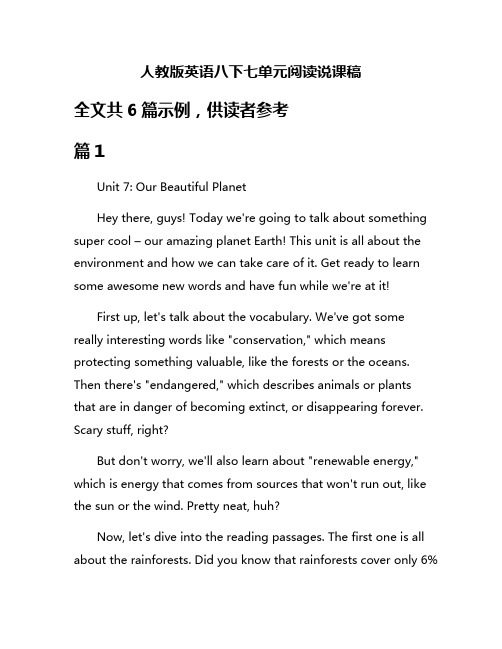
人教版英语八下七单元阅读说课稿全文共6篇示例,供读者参考篇1Unit 7: Our Beautiful PlanetHey there, guys! Today we're going to talk about something super cool – our amazing planet Earth! This unit is all about the environment and how we can take care of it. Get ready to learn some awesome new words and have fun while we're at it!First up, let's talk about the vocabulary. We've got some really interesting words like "conservation," which means protecting something valuable, like the forests or the oceans. Then there's "endangered," which describes animals or plants that are in danger of becoming extinct, or disappearing forever. Scary stuff, right?But don't worry, we'll also learn about "renewable energy," which is energy that comes from sources that won't run out, like the sun or the wind. Pretty neat, huh?Now, let's dive into the reading passages. The first one is all about the rainforests. Did you know that rainforests cover only 6%of the Earth's land surface, but they're home to more than half of the world's plants and animals? Crazy, right?The passage talks about how rainforests are being destroyed at an alarming rate, mostly because people are cutting down trees to make room for farms and cities. This is really bad news for all the amazing creatures that live there, like the jaguar, the orangutan, and the toucan.But don't worry, there are lots of people and organizations working hard to protect the rainforests. They're teaching local communities how to use the forest in a sustainable way, which means using it without destroying it. Pretty cool, huh?The next reading is about the oceans, and let me tell you, it's a real eye-opener. Did you know that the oceans cover more than 70% of the Earth's surface? That's a lot of water!Unfortunately, the oceans are facing some serious threats, like pollution and overfishing. Pollution is when people dump garbage and chemicals into the water, which can hurt or even kill the creatures that live there. Overfishing is when people catch too many fish, which can make some species disappear forever.But don't worry, there are lots of people working to protect the oceans, too. They're setting up marine reserves, which areareas of the ocean where fishing is banned, so the fish can breed and the ecosystem can recover.The last reading is all about climate change, which is a really big deal. Basically, the Earth is getting warmer because of things like burning fossil fuels and cutting down trees. This is causing all sorts of problems, like melting glaciers, rising sea levels, and more extreme weather events like hurricanes and droughts.But don't worry, there are things we can do to help! We can reduce our carbon footprint by using less energy, recycling, and planting more trees. We can also switch to renewable energy sources like solar and wind power.Phew, that was a lot of information, wasn't it? But don't worry, we'll have plenty of fun activities and games to help us learn and remember everything.For example, we'll play a memory game with the new vocabulary words, and we'll do a scavenger hunt around the school to find examples of things that are good or bad for the environment.We'll also watch some cool videos about animals in the rainforest and the oceans, and we'll do some fun experiments to learn about renewable energy.And of course, we'll have lots of opportunities to practice our reading, writing, and speaking skills. We'll write persuasive letters to our local government about protecting the environment, and we'll have debates and discussions about the best ways to tackle climate change.So, are you guys ready to dive in and learn all about our beautiful planet? I know I am! Let's do this!篇2Unit 7: A Balanced LifeHi everyone! Today we're going to learn about having a balanced life in Unit 7 of our English textbook. It's a really important topic that I think will be useful for all of us as we grow up.The unit starts with a reading passage called "Time for Everything" on pages 56-57. It's about a student named Mike who has a pretty busy schedule with school, sports, music lessons, and hanging out with friends. At first, Mike feels overwhelmed trying to fit everything in. But then his parents give him some good advice about making a schedule and setting priorities.I can totally relate to Mike's situation! With all my classes, homework, extracurricular activities, and wanting to spend time with family and friends, it's easy to feel pulled in a million directions. Making a schedule and focusing on what's most important has really helped me too.After the reading, there are some vocab exercises on words like "schedule", "priority", and "commitment". The vocabulary really reinforces the main ideas of balancing your responsibilities and making time for the things that matter most to you.Then on pages 58-59, there's a section called "Study Corner" all about effective time management skills. It gives tips like making a weekly schedule, prioritizing tasks, avoiding procrastination, and taking breaks to recharge. As students, we can definitely use all those strategies!My favorite part is the dialogue on page 59 where two students named Amy and Bill discuss how they organize their schedules. Amy is kind of all over the place, staying up late and leaving things to the last minute. But Bill is really disciplined about planning his time, setting goals, and sticking to routines. I want to be more like Bill!The exercises that go along with the dialogue have us identify good and bad time management habits. It's a nice way to reinforce those positive behaviors we should aim for.After that, there are reading exercises about Mike's schedule from the first passage. We have to put events in order, make inferences, and summarize the main ideas. Working through those helped me understand how to effectively manage my own schedule.The writing section on pages 62-63 is where we really get to apply what we've learned about time management. The sample shows a weekly schedule formatted into a table with different blocks for activities like studying, sports, chores, and free time.Our task is to write about a typical week in our lives, including our various responsibilities and how we balance it all. I'm planning to make a nice colorful schedule and write a paragraph about my strategies for dealing with it all.Learning all these skills for managing our time and responsibilities is so valuable. As we get older, life is only going to get more demanding with bigger workloads, jobs, relationships, and other commitments.If we can develop good habits now for prioritizing what's important, making schedules, setting goals, and avoiding procrastination, it will prepare us to live more balanced and fulfilling lives in the future. That's the key takeaway I'm getting from this unit.So those are the highlights! We covered helpful vocabulary, time management tips, sample schedules, and tasks for creating our own weekly plans. I feel much more equipped to handle my busy life as a student in a balanced way after studying this unit.Shout out to our English textbook writers for giving us such valuable life lessons along with language learning! Let me know if any of you need help making your own schedules. It's a skill we'll definitely all need as we grow up. That's all for my summary of Unit 7 - thanks for reading!篇3My Lesson Plan for Unit 7 ReadingHi there! Today I'm going to teach you about the reading passage from Unit 7 of our English textbook. It's all about ancient Egyptian civilization. I think this topic is super cool - I love learning about how people lived a really long time ago!To start, let me give you some background on ancient Egypt. It was a country located in north Africa along the Nile River. The Nile was really important because it provided water for farming and transportation. The ancient Egyptians built their civilization there starting around 3100 BC, which was over 5,000 years ago! Can you imagine living that long ago? They had a very advanced society with amazing accomplishments in areas like architecture, writing, art, and more.The reading passage gives an overview of different aspects of ancient Egyptian culture. Let me walk you through the key points:Life in Ancient EgyptThe first part talks about how important the Nile River was. It flooded every year, leaving behind fertile soil perfect for growing crops like wheat, barley, vegetables, and fruits. This allowed the Egyptians to have a good food supply. They didn't have to move around nomadically but could settle down in villages and cities. Pretty convenient, right?It then describes the hierarchy of Egyptian society. At the very top was the pharaoh who ruled over everyone. Pharaohs were considered gods and had absolute power. Below them were nobles, priests, soldiers, scribes and other officials. Thencame skilled workers like farmers, craftspeople and merchants. At the bottom were peasants who did manual labor and servants.One cool thing was that sons could get training to move up in society, which was rare back then. So if you were a peasant kid, you might have been able to become a scribe or other respected profession through education. Sweet deal!Religion and the AfterlifeThe next section is about Egyptian religious beliefs. They had many gods, like Ra the sun god, Osiris god of the afterlife, and the cat goddess Bastet. Egyptians believed the pharaoh would join the gods as a spirit when he died.Speaking of death, Egyptians put a ton of effort into preparing for the afterlife. They mummified bodies by removing organs and dehydrating the remains to preserve them. Then they built huge pyramid tombs filled with treasures and supplies the dead person might need.My favorite part is about mummies and the wild things they'd bury with pharaohs, like solid gold chariots, jewelry, food, furniture and even pets! Just imagine getting to take all your cool stuff with you after you died. So extra.Achievements and Daily LifeTowards the end, it covers some major Egyptian innovations. Writing was huge - they developed hieroglyphs, one of the earliest writing systems in the world. The pyramids were architectural masterpieces that we still can't quite figure out how they built. They pioneered make-up, glass, paper and more. These guys were geniuses!It wraps up with daily life topics like what peasants wore, how they cooked, games they played, etc. Gives you a window into what being a regular Egyptian was like. They seemed to work hard but also made time for family, artistic pursuits and leisure when they could.Isn't it mind-blowing that people created such an incredible society thousands of years before modern technology? Learning about it really makes me appreciate how far humanity has come. At the same time, the Egyptians accomplished so much with just basic tools and human effort. Pretty inspiring if you ask me!Okay, that covers the main ideas from the reading. Let me know if you need any clarification or have other questions! I'm happy to discuss more about this fascinating ancient culture. Understanding history allows us to better understand our world today.篇4Hey there, kids! Today, we're going to talk about something super cool – English reading! I know, I know, you might be thinking, "Reading? Boring!" But trust me, this is going to be fun!In Unit 7 of your English textbook, we're going to learn about some amazing people who have made a big difference in the world. We'll read about their lives and the things they've done to make the world a better place.First up, we have Marie Curie. She was a scientist who lived in the 1800s and 1900s. Can you imagine how different the world was back then? No smartphones, no video games, and no internet! Despite all the challenges she faced, Marie Curie never gave up on her love for science.She was the first woman to win a Nobel Prize, which is like the biggest award you can get for being super smart and making important discoveries. Marie Curie discovered two new elements – radium and polonium – and her work helped us understand radiation better.Next, we'll learn about Helen Keller. She was born in 1880 and became blind and deaf when she was just a baby. Can you imagine how hard life must have been for her? She couldn't seeor hear anything! But Helen was a fighter, and she never let her disabilities stop her.With the help of her amazing teacher, Anne Sullivan, Helen learned how to communicate using sign language and Braille (that's a special way of reading and writing using raised dots). She went on to become a famous author and speaker, fighting for the rights of people with disabilities.Then, there's Wilma Rudolph, a track and field athlete from the United States. She was born in 1940 and had to overcome many challenges growing up. As a child, she suffered from polio, a disease that can make it hard to walk or even move your legs.But Wilma was determined to run, and with hard work and perseverance, she became an Olympic champion! She won three gold medals in the 1960 Olympic Games, proving that anything is possible if you believe in yourself and never give up.Isn't it amazing how these people overcame so many obstacles and achieved incredible things? Reading about their lives can teach us valuable lessons about courage, determination, and the power of never giving up.As we read through Unit 7, we'll learn more fascinating stories and interesting facts about these remarkable individuals.We'll also practice our English reading, vocabulary, and comprehension skills along the way.So, get ready to be inspired, kids! This unit is going to be a journey filled with excitement, learning, and plenty of opportunities to improve your English. Let's dive in and discover the incredible lives of Marie Curie, Helen Keller, Wilma Rudolph, and many more!篇5Unit 7: A Brighter FutureHi everyone! Today we're going to learn about Unit 7 of our English textbook. This unit is called "A Brighter Future" and it talks about hopes and dreams for the future. I'm really excited to share what I've learned with you!The unit starts with a reading passage called "My Dreams". It's about a boy named Mike who writes about his dreams for the future. He wants to be an astronaut and travel to space! I think that's such a cool dream. In the passage, Mike talks about how he's always been fascinated by the stars and planets. When he was little, he used to look up at the night sky with his dad and imagine what it would be like to fly among the stars. Doesn't that sound magical?Mike also writes about how he's going to work really hard in school to make his dream come true. He knows that becoming an astronaut takes a lot of studying, especially in subjects like math, science, and engineering. But Mike is determined to never give up on his dream. I admire his passion and dedication!After the reading, there are some comprehension questions to check our understanding. Some of the questions ask about the details of Mike's dream, while others focus on vocab words from the passage. There's also a question that asks us to share our own dreams for the future. I can't wait to hear what everyone else wants to be when they grow up!The next part of the unit is the language notes section. Here, we learn about different grammar points and sentence patterns that are useful for talking about the future. One of the key grammar points is the future tense, like "I will travel to space" or "She is going to be a doctor." We also learn about phrases for expressing hopes and dreams, such as "My dream is to..." or "I hope to become a..."Then we move on to the listening part of the unit. There's a dialogue between two friends, Anna and Jack, discussing their future plans. Anna wants to be a teacher because she loves working with children. Jack, on the other hand, dreams of being afamous artist. They encourage each other to pursue their passions and never give up on their dreams. Listening to their conversation makes me feel motivated to chase after my own dreams too!After the listening, there are some fun activities to practice what we've learned. One activity has us role-play different dream jobs, like being a chef, a professional athlete, or even the president! Another activity involves writing our own short story about achieving our dream in the future. I can't wait to use my imagination for that one.The final section of the unit is the project task. For this, we have to work in small groups and create a poster or presentation about our dreams for the future. We can include drawings, photos, and other creative elements to make it look really cool. Then, we'll present our projects to the rest of the class. I'm a little nervous about the presentation part, but I know it'll be a great way to practice our English speaking skills.Overall, I'm really enjoying Unit 7 so far. It's teaching me not only English skills, but also valuable life lessons about dreaming big and working hard to achieve my goals. A brighter future is out there, and with dedication and perseverance, any dream is possible!Well, that's all I have to share about this unit. Let me know if you have any other questions! I'm always happy to discuss more about the topics we're learning. Until next time, keep dreaming and studying hard!篇6Hello everyone! Today we're going to talk about the reading passage in Unit 7 of our English textbook. It's called "The First Basketball Game" and it's all about the invention of the sport of basketball. Pretty cool, right?The passage starts by telling us that basketball was invented in 1891 by a teacher named James Naismith. He was working at a college in Massachusetts and was asked to come up with an indoor game that his students could play during the cold winter months. Back then, there weren't any good indoor sports for people to play, so Naismith had to get creative.He set up two peach baskets at opposite ends of the gymnasium and got the idea that players could try to throw a soccer ball into the baskets. That's where the name "basketball" comes from! The passage says the first game was pretty boring though, since every time a point was scored, someone had to use a ladder to retrieve the ball from the basket. Can you imaginehaving to stop and do that every time? It would make the games last forever!Eventually, someone realized they could just cut out the bottom of the baskets so the ball could fall through. Genius! That small change made the games a lot faster and more fun. From those humble beginnings of peach baskets and a soccer ball, basketball quickly became a popular sport.The reading talks about how the original 13 rules of basketball were published in 1892. Things like how many players were on each team, what the court dimensions were, how scoring worked, and rules against running with the ball or striking it with your fists. The basics that we still use today! Except now if you punch the ball, you'll probably get kicked out of the game.It's crazy to think that from those 13 simple rules written over 130 years ago, basketball became one of the biggest sports in the world. The passage mentions that by the early 1900s, it had already spread to other colleges, YMCAs, and amateur clubs across the United States. And these days, you can find kids playing basketball everywhere from parks to school gyms to driveways. Even the NBA with all its superstar players and crazy dunks came from Naismith's little indoor game.The reading wraps up by talking about how Naismith moved around as a teacher and coach for many years after inventing basketball. He lived until 1939 and even got to see his creation turn into a hugely popular professional sport before he died. In 1959, Naismith was inducted into the Basketball Hall of Fame as the "inventor of basketball." What an incredible legacy for a P.E. teacher who was just trying to keep his students active in the winter!That's the main idea behind the "The First Basketball Game" reading. Just a regular guy coming up with a clever game to solve a problem, and it turned into this global phenomenon we all know and love today. Whether you're a basketball fan or not, you have to admit Naismith's invention was pretty special.So those are the key points I took from the passage. Let me quickly summarize:Basketball invented in 1891 by James NaismithOriginal game used peach baskets and soccer ballNaismith wrote 13 original rules in 1892Spread quickly and became massively popular worldwideNaismith inducted into Basketball Hall of Fame in 1959I think the reading does a great job of explaining the humble origins of basketball in a fun, engaging way. Naismith seems like he was a pretty smart cookie to dream up a game that became so big. And it's a good reminder that you never know what world-changing ideas might come from solving a simple problem. You just need a peach basket, a ball, and a little creativity!Alright, that's all I've got for my analysis of "The First Basketball Game." Let me know if you have any other questions! Thanks for listening, everyone.。
人教版八年级英语下册《Unit 7 Would you mind turning down the music.(通用)》教案_3
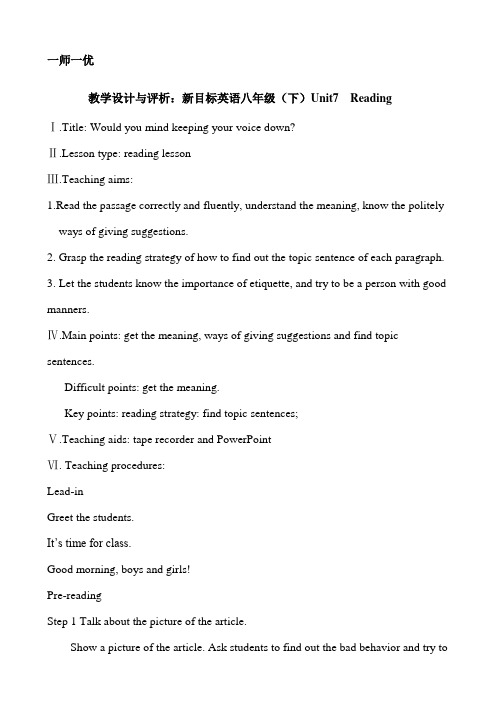
一师一优教学设计与评析:新目标英语八年级(下)Unit7 ReadingⅠ.Title: Would you mind keeping your voice down?Ⅱ.Lesson type: reading lessonⅢ.Teaching aims:1.Read the passage correctly and fluently, understand the meaning, know the politely ways of giving suggestions.2. Grasp the reading strategy of how to find out the topic sentence of each paragraph.3. Let the students know the importance of etiquette, and try to be a person with good manners.Ⅳ.Main points: get the meaning, ways of giving suggestions and find topic sentences.Difficult points: get the meaning.Key points: reading strategy: find topic sentences;Ⅴ.Teaching aids: tape recorder and PowerPointⅥ. Teaching procedures:Lead-inGreet the students.It’s time for class.Good morning, boys and girls!Pre-readingStep 1 Talk about the picture of the article.Show a picture of the article. Ask students to find out the bad behavior and try togive them some suggestions.Look at the picture. Where are they? What is she doingIf you see someone doing this what would you say?If some one is talking loudly, what would you say?(Would you mind not talking loudly?) Or we can say: “Would you mind keeping your voice down?”Step 2 Predict the content according to the title.Ask students: “What is the article about?” Let them choose from A B C D.While-readingStep 3 Skimming: Reading strategyExplain what topic sentence. Take paragraph 1 as an example. Then ask students to find out the topic sentences of the following paragraphs.Before re ading, let’s learn something about topic sentences. They can make reading easier.A topic sentence can give you the main idea of the paragraph. It is usually in the first and the last sentence of each paragraph.Match the paragraphs with the best summaries.Step 4 ScanningWell done! You have got the main idea of the article, let’s read it again for more detail.Listen and read the article paragraph by paragraph and finish the following tasks. Read para 1, answer the question “What does etiquette mean?”It means normal and polite social behavior.Read para 2, find out three examples of bad behavior.Check the answers. Is standing close to someone impolite in China? In China, we can stand close to each other. But in Europe, such as England, France if you stand close to others, they’ll feel uncomfortable. They won’t feel good.Can we talk loudly at our own home? Where can’t we talk loudly In public places. Can you tell me some public places?Read para 3, find out two examples of bad behavior.Smoke in publicRead para 4, find out one examples of bad behavior.Drop litter.Post-readingStep 5 Group discussionMatch the right polite suggestions with each bad behavior.I believe you won’t do such kind of things. But if you see some doin g these things, what would you do? Would you give them some polite suggestions Please match bad behavior with the right suggestions?Step 6 Show timeOne student chooses a note of bad behavior from the teacher and acts it out. Other students give polite suggestions according to the performance.I think you can give many polite suggestions now. Let’s relax ourselves. I’d like to invite a student to come here and get a note from me. Act the bad behavior out. Other students give some polite suggestions.e.g. Drop litter.After performance, other students give suggestions and the teacher asks the “actor”: “What should you do?” Lead the student to pick it up.Step 7SummaryAsk students to discuss what we learned today.Hints: Rules of etiquetteWays of giving suggestionsReading strategyStep 8 Homework: WritingOne day you saw someone breaking the rules of etiquette. Write a letter of complain to your local newspaper.Step 9 Blackboard designUnit7 Reading非常有礼貌的请求别人做某事:肯定: Would you mind + doing …?否定: Would you mind not + doing…?Team 1 Team 2 Team 3 Team 4 Team 5 Team 6教学评析黑龙江省农垦牡丹江管理局机关子弟校梁海涛一、教学内容:本课选自新目标英语八年级下册第七单元阅读课文。
八年级下册英语第七单元教案
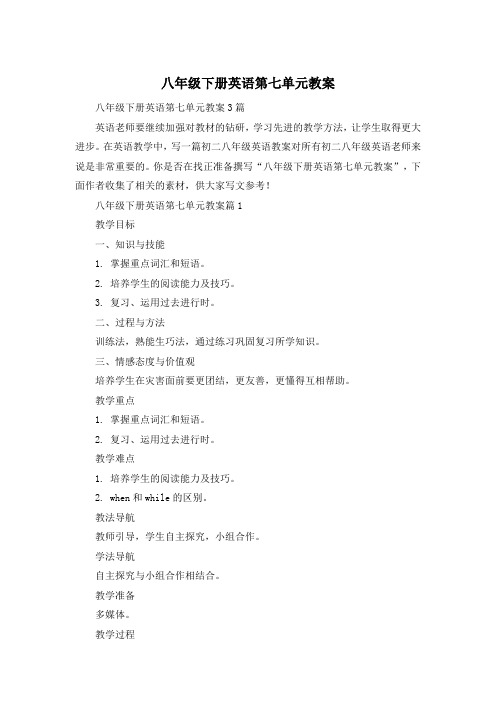
八年级下册英语第七单元教案八年级下册英语第七单元教案3篇英语老师要继续加强对教材的钻研,学习先进的教学方法,让学生取得更大进步。
在英语教学中,写一篇初二八年级英语教案对所有初二八年级英语老师来说是非常重要的。
你是否在找正准备撰写“八年级下册英语第七单元教案”,下面作者收集了相关的素材,供大家写文参考!八年级下册英语第七单元教案篇1教学目标一、知识与技能1. 掌握重点词汇和短语。
2. 培养学生的阅读能力及技巧。
3. 复习、运用过去进行时。
二、过程与方法训练法,熟能生巧法,通过练习巩固复习所学知识。
三、情感态度与价值观培养学生在灾害面前要更团结,更友善,更懂得互相帮助。
教学重点1. 掌握重点词汇和短语。
2. 复习、运用过去进行时。
教学难点1. 培养学生的阅读能力及技巧。
2. when和while的区别。
教法导航教师引导,学生自主探究,小组合作。
学法导航自主探究与小组合作相结合。
教学准备多媒体。
教学过程Step 1 GreetingsGreet the students as usual.Step 2 RevisionAsk students to talk about what they were doing last night in groups of four then give a report.Step 3 PresentationAsk the students to look at the picture and think about what has happened.Step 4 Reading3a, Read the passage quickly and answer the following questions1. What was the weather like before the heavy rain started?2. What was the neighborhood like after the storm?Ask some students to report their answers.3b, Read the passage again and plete the sentences using information from the passage.1. When the news on TV was reported,strong winds # outside.2. While Ben’s mom was making sure the radio was working,his dad #.3. Ben # when the heavy rain finally started.4. When Ben #at 3:00 .,the wind #.Ask some students to report their answers.Step 5 Speaking3c, Discuss the questions with a partner.“Although the storm broke many things apart,it brought families and neighbors closer together.”What other can bring people closer together? How can we help each other in times of difficulty?Ask some students to report their answers.Step 6 Language points1. With no light outside,it felt like midnight.此句中介词with表示一种伴随状况,同时还包含着某种因果关系,表示“因某种状况的存在而导致…”,因此可翻译成“由于;因为”等。
人教版新目标初中英语八年级下册《Unit 7 reading》说课稿
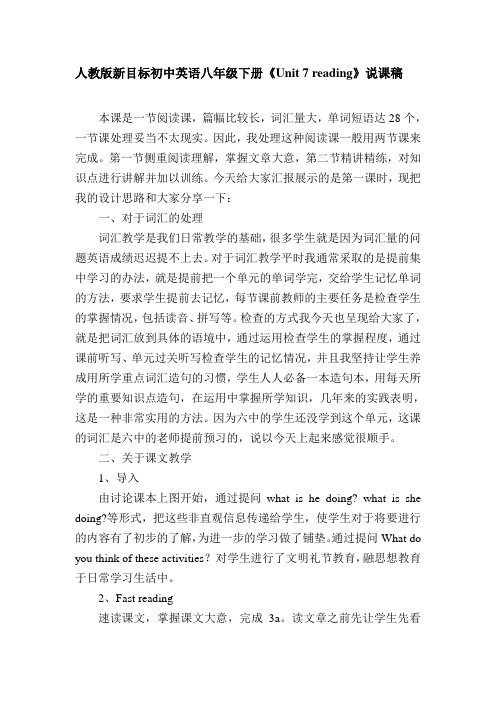
人教版新目标初中英语八年级下册《Unit 7 reading》说课稿本课是一节阅读课,篇幅比较长,词汇量大,单词短语达28个,一节课处理妥当不太现实。
因此,我处理这种阅读课一般用两节课来完成。
第一节侧重阅读理解,掌握文章大意,第二节精讲精练,对知识点进行讲解并加以训练。
今天给大家汇报展示的是第一课时,现把我的设计思路和大家分享一下:一、对于词汇的处理词汇教学是我们日常教学的基础,很多学生就是因为词汇量的问题英语成绩迟迟提不上去。
对于词汇教学平时我通常采取的是提前集中学习的办法,就是提前把一个单元的单词学完,交给学生记忆单词的方法,要求学生提前去记忆,每节课前教师的主要任务是检查学生的掌握情况,包括读音、拼写等。
检查的方式我今天也呈现给大家了,就是把词汇放到具体的语境中,通过运用检查学生的掌握程度,通过课前听写、单元过关听写检查学生的记忆情况,并且我坚持让学生养成用所学重点词汇造句的习惯,学生人人必备一本造句本,用每天所学的重要知识点造句,在运用中掌握所学知识,几年来的实践表明,这是一种非常实用的方法。
因为六中的学生还没学到这个单元,这课的词汇是六中的老师提前预习的,说以今天上起来感觉很顺手。
二、关于课文教学1、导入由讨论课本上图开始,通过提问what is he doing? what is she doing?等形式,把这些非直观信息传递给学生,使学生对于将要进行的内容有了初步的了解,为进一步的学习做了铺垫。
通过提问What do you think of these activities?对学生进行了文明礼节教育,融思想教育于日常学习生活中。
2、Fast reading速读课文,掌握课文大意,完成3a。
读文章之前先让学生先看3a 中的6个选项,接着只看每段的第一句,让学生有目的的去搜寻所需材料,起到了事半功倍的效果。
学生找到主旨句后让他们集体读一读,加深了学生对文章的理解,为下一步的复述课文打下了良好的基础。
人教版初中英语八年级下册unit7reading公布课教案

人教版初中英语八年级下册Unit 7 Reading公布课教案Would you mind keeping your voice down?一、教材分析〔一〕教材的地位和作用“Would you mind keeping your voice down ?〞是一篇有关礼节的阅读,是对整个单元的升华,在前几节课中,学生运用了Would you mind...? 有礼貌地对他人发出请求,本节课通过文章进一步加深对有礼貌请求句式的明白得和在生活中的具体运用,同时通过对中西方礼节的对照和描述,使学生能够感受到在那个由“人〞组成的社会中,每一个人只有标准好自己的言行,讲究礼节,才能使整个社会处于一个“有序、和谐〞的社会状态里,由此进一步提高学生的听、说、读写的综合能力。
〔二〕教学目标确实立一、语言知识目标a.辞汇:voice, term, Asian, Europe, impolite, allow, public, cough, smoke, drop, litter, pick...up, behave.b.语法:明白得“Would you mind doing...〞的全然形式和表意功能。
二、情感态度目标:培育学生在公共场合及日常生活中文明礼貌,以礼待人的优良品质。
3、学习策略目标:a.学习利用文章中的主题句快速明白得文章大意;b.依照图片、上下文猜想、明白得语篇中词语和句子;4、文化意识目标:了解中西方礼节的不同与一样,从而加深对中西方文化的明白得。
二、教学环节的设计八年级学生有必然的英语根底知识,求知欲很强,因此,本节课讲解的时刻很少,主若是训练学生利用任务型及合作式,以教师为辅,学生为主的教学原那么,训练学生在学习中获取信息,处置信息和运用信息的能力。
三、教学程序一、导入与指导给学生展现几幅在公共场合违背规那么的图片,通过让学生回答What are they doing 和If that happens, what will you say? 这2个问题,一起讨论这些人的违规行为,由此引出本课的新单词drop, litter, spit, pick up, behave, cough等,同时也温习了前面学生已把握的Would you mind (not) doing ...? 句型,也激发了学生对本课的爱好,我以为采纳图片导入法,远比直接让学生翻书阅读更能激发学生的爱好,使其由被动学习变成主动获取知识。
人教版八年级英语下册Unit7SectionB2b阅读课教学设计

(三)教学设想
1.导入环节:通过头脑风暴的方式,让学生思考并分享自己的学习方法和目标,激发学生的学习兴趣,为新课的学习做好铺垫。
2.新课呈现:利用多媒体教学资源,呈现与本节课主题相关的图片和视频,引导学生学习新词汇,并通过例句展示词汇的用法。
3.阅读活动:
-预测:让学生根据文章标题和图片,预测文章内容,培养学生的预测能力。
-扫读:让学生快速阅读文章,寻找关键信息,培养学生快速获取信息的能力。
-细读:引导学生深入阅读文章,分析文章结构,理解文章细节,并进行问题链式的讨论,提高学生的阅读理解能力。
4.语法环节:结合文章内容,引导学生观察并总结一般现在时和一般过去时的用法,通过练习巩固语法知识。
三、教学重难点和教学设想
(一)教学重点
1.掌握本节课的核心词汇和句型,如"effective", "achieve", "goal", "make decisions", "set goals"等,并能运用到实际语境中。
2.理解并运用一般现在时和一般过去时描述学习方法和个人目标。
3.提高阅读理解能力,能够把握文章的主旨大意,分析文章的细节信息。
3.学生在语法方面,对一般现在时和一般过去时的运用尚可,但在实际语境中灵活运用时,部分学生容易出错,需要教师在教学中加强巩固。
4.学生在学习态度上,大部分学生表现出积极的学习态度,但部分学生对英语学习缺乏自信,课堂参与度不高,需要教师关注并激发这部分学生的学习兴趣。
5.学生在合作学习方面,具备一定的小组合作能力,但在分工、讨论和展示环节仍存在一定的问题,需要教师引导和培养。
人教英语八年级下册Unit7SectionB阅读课优秀教学案例

(三)小组合作
1.分组讨论:将学生分成小组,让他们就文章内容进行讨论和交流,促进学生之间的互动和合作。
2.小组活动:设计一些小组活动,如共同完成任务、解决问题等,让学生在实际操作中运用所学知识,提高实际问题解决能力。
3.小组分享:鼓励小组成员分享自己的观点和经验,培养学生的表达能力和批判性思维。
(四)反思与评价
2.作业反馈:对学生的作业进行及时反馈,指出其中的不足之处,帮助学生改进和提高。
3.鼓励学生自我总结:鼓励学生在课后对自己的学习过程进行总结,反思自己在课堂上的表现和学习成果。
作为一名特级教师,我在本节课中运用了导入新课、讲授新知、学生小组讨论、总结归纳和作业小结等多种教学内容与过程。通过这些教学内容与过程的实施,我能够更好地引导学生参与课堂活动,激发他们的学习兴趣和积极性,培养他们的思维能力和合作能力。同时,我也能够及时了解学生的学习情况,对他们的学习过程进行有效指导和反馈,帮助他们实现自己的学习目标,提高他们的英语阅读能力和综合素质。
4.设计一些实践活动,如小组讨论、角色扮演等,让学生将所学知识运用到实际情景中,提高学生的实际问题解决能力。
(三)情感态度与价值观
1.通过讨论和分享,让学生认识到面对压力是每个人成长过程中的一部分,培养学生正确面对困难和挑战的心ห้องสมุดไป่ตู้。
人教版8年级下册英语Unit 7 Section B Reading课程教学设计
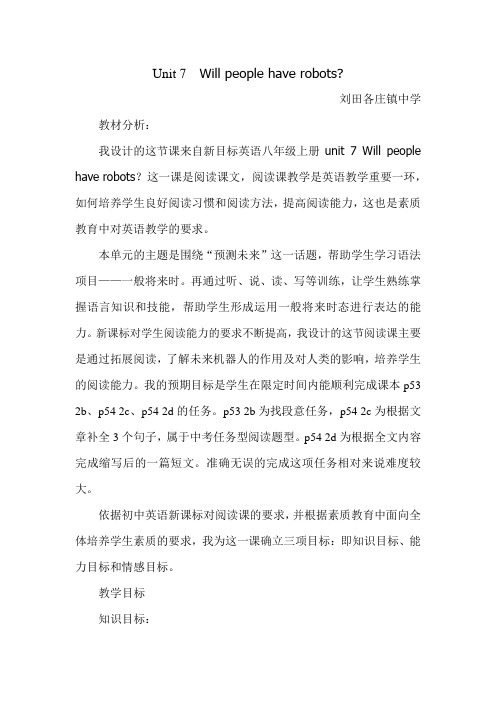
Unit 7 Will people have robots?刘田各庄镇中学教材分析:我设计的这节课来自新目标英语八年级上册unit 7 Will people have robots?这一课是阅读课文,阅读课教学是英语教学重要一环,如何培养学生良好阅读习惯和阅读方法,提高阅读能力,这也是素质教育中对英语教学的要求。
本单元的主题是围绕“预测未来”这一话题,帮助学生学习语法项目——一般将来时。
再通过听、说、读、写等训练,让学生熟练掌握语言知识和技能,帮助学生形成运用一般将来时态进行表达的能力。
新课标对学生阅读能力的要求不断提高,我设计的这节阅读课主要是通过拓展阅读,了解未来机器人的作用及对人类的影响,培养学生的阅读能力。
我的预期目标是学生在限定时间内能顺利完成课本p53 2b、p54 2c、p54 2d的任务。
p53 2b为找段意任务,p54 2c为根据文章补全3个句子,属于中考任务型阅读题型。
p54 2d为根据全文内容完成缩写后的一篇短文。
准确无误的完成这项任务相对来说难度较大。
依据初中英语新课标对阅读课的要求,并根据素质教育中面向全体培养学生素质的要求,我为这一课确立三项目标:即知识目标、能力目标和情感目标。
教学目标知识目标:1、运用一般将来时态谈论未来生活或个人梦想2、了解未来机器人的作用及对人类的影响能力目标:1、培养能灵活运用所学知识流畅地表达自己想法的能力。
2、训练学生掌握良好的阅读习惯和阅读方法,即跳读、略读、速读和限时阅读等。
情感目标:1、培养学生良好的学习态度。
2、通过阅读,培养学生热爱科学的品质。
重点难点重点:本课的重点在于培养和发展学生阅读能力,在有效时间内提高阅读效率,同时让学生在最短时间领会文章主旨。
难点:学会通过短时间阅读把握文章主旨的能力。
教学手段:多媒体辅助教学,有助于让学生从视觉上感受本节课内容,激发学生兴趣,活跃课堂气氛,从而优化英语教学过程。
教学方法:任务型教学教学过程:(课堂的整体设计我遵循整体教学的思路,共分六个主要步骤进行)一、通过屏幕展示宇航员刘洋和电脑工程师比尔·盖茨的图片,引导学生用“What will you be in ten years?——I’ll be a(an)…”进行对话练习。
Unit7SectionBReading教学设计人教版八年级英语下册
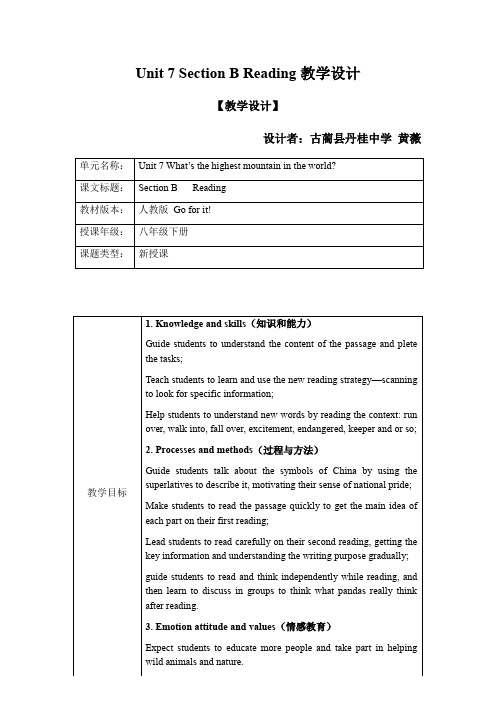
Whilereading activities:
Task 3: Read first part(para.1and para. 2) carefully then finish the tasks.
Lead students to read carefully on their second reading, getting the key information and understanding the writing purpose gradually;
guide students to read and think independently while reading, and then learn to discuss in groups to think what pandas really think after reading.
Unit 7 Section B Reading教学设计
【教学设计】
设计者:古蔺县丹桂中学黄薇
单元名称:
Unit7What’s the highest mountain in the world?
课文标题:
Section BReading
教材版本:人教版GFra bibliotek for it!
授课年级:
八年级下册
课题类型:
We Share
Postreading activity:
1、Fill the mindmap and retell the passage.
2、Conclusion
人教版八年级英语下册Unit7SectionBReading教学设计

c.文化背景介绍:结合文章内容,适时介绍希望工程的背景知识,帮助学生理解文章。
3.教学过程设计:
a.导入:通过图片、视频等资源,激发学生对希望工程的兴趣,为新课学习做好铺垫。
b.阅读环节:引导学生运用阅读策略,完成文章阅读,并总结文章大意。
c.语法讲解:结合文章中的句子,讲解一般过去时和现在完成时的用法,让学生在实际语境中感受语法知识。
人教版八年级英语下册Unit7SectionBReading教学设计
一、教学目标
(一)知识与技能
1.学生能够掌握本节课的核心词汇和短语,如"public", "set up", "donate", "fund", "raise money"等,并能在实际语境中正确运用。
2.学生能够理解并运用一般过去时和现在完成时描述过去发生的事情及其对现在的影响。
d.课堂活动:设计填空、排序、角色扮演等任务,让学生在活动中运用所学知识,提高语言运用能力。
e.课堂总结:对本节课的重点知识进行回顾,巩固所学。
4.教学评价:
a.过程性评价:关注学生在课堂上的表现,包括参与度、合作交流、任务完成情况等。
b.终结性评价:通过课后作业、单元测试等方式,检测学生对知识的掌握程度。
3.鼓励学生发挥创意,将所学知识运用到实际情境中,提高学习兴趣。
4.作业评价要关注学生的过程表现,鼓励他们积极参与、予表扬,对存在的问题给予指导和纠正。
3.学生在学习过程中,树立正确的价值观,认识到知识的力量,激发学习的积极性和主动性。
4.学生通过学习英语,增强国际视野,了解世界各地的文化差异,培养跨文化交际意识。
人教版八年级英语下册Unit7SectionBReading说课稿
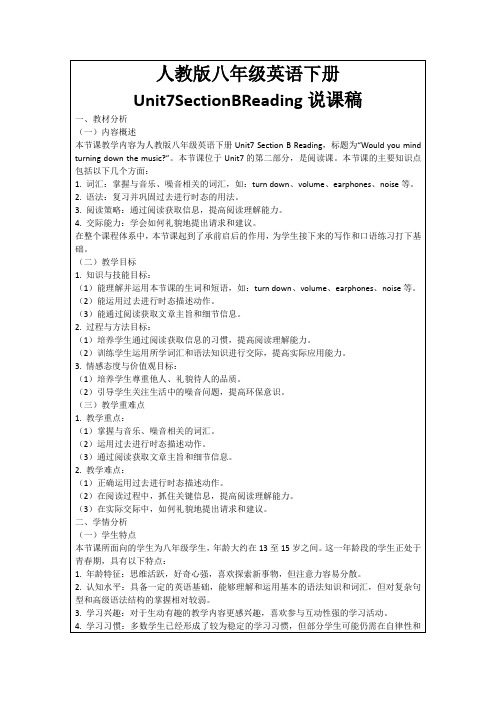
一、教材分析
(一)内容概述
本节课教学内容为人教版八年级英语下册Unit7 Section B Reading,标题为“Would you mind turning down the music?”。本节课位于Unit7的第二部分,是阅读课。本节课的主要知识点包括以下几个方面:
3.风格:使用清晰的字体,重要信息用不同颜色标注,图表和流程图辅助说明复杂概念。
板书在教学过程中的作用是提供一个视觉辅助工具,帮助学生理解和记忆课程内容。为确保板书清晰、简洁且有助于学生把握知识结构,我会提前规划板书内容,避免过度拥挤,保持条理清晰,并在课后与学生反馈,了解板书的有效性。
(二)教学反思
能力。
(3)在实际交际中,如何礼貌地提出请求和建议。
二、学情分析
(一)学生特点
本节课所面向的学生为八年级学生,年龄大约在13至15岁之间。这一年龄段的学生正处于青春期,具有以下特点:
1.年龄特征:思维活跃,好奇心强,喜欢探索新事物,但注意力容易分散。
2.认知水平:具备一定的英语基础,能够理解和运用基本的语法知识和词汇,但对复杂句型和高级语法结构的掌握相对较弱。
1.利用多媒体教学,如播放与课文内容相关的视频或音频,增加课堂趣味性。
2.设计角色扮演活动,让学生模拟课文中的场景,提高学生的参与度和实际运用能力。
3.创设真实的语言环境,让学生在实际语境中学习,如讨论校园中的噪音问题,引导学生关注生活实际。
4.采用小组合作学习方式,鼓励学生相互交流,共同完成任务,增强团队协作能力。
1.词汇:掌握与音乐、噪音相关的词汇,如:turn down、volume、earphones、noise等。
Unit7SectionA(3a-3c)Reading教案2023-2024学年人教版八年级英语下册
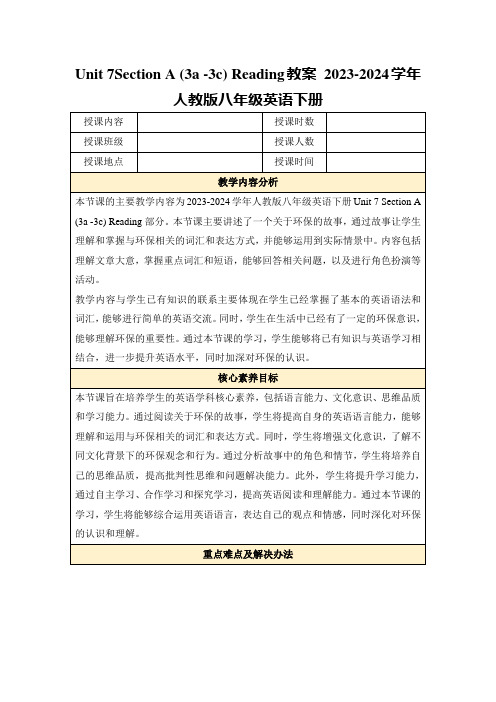
5.教学工具:准备多媒体投影仪、计算机、音响设备等教学工具,以便进行多媒体演示和教学活动。同时,确保每个学生都能清晰地看到投影屏幕,以便更好地参与课堂互动和学习。
2.文化意识:学生将增强对环保文化意识的理解,认识到环保是一个全球性的问题,不同国家和地区都在努力解决环境污染和资源短缺等问题。他们将了解到环保的重要性,并意识到自己作为地球公民的责任和义务。
3.思维品质:学生将培养自己的批判性思维和问题解决能力,通过分析故事中的角色和情节,他们能够思考环保问题的原因和解决办法。他们将学会从不同的角度思考问题,并提出创新的解决方案。
1.语言能力:学生将能够听懂、读懂并准确运用与环保相关的词汇和表达方式,如“environmental protection”、“waste reduction”、“recycling”等。他们还能够流利地表达自己对环保的看法和想法,如“I think we should use public transportation more often to reduce air pollution”或“We need to take action to protect our planet for future generations”。
6.学习平台:如果可能的话,可以使用学习平台或在线教学工具,如电子白板、学习管理系统等,以便进行互动式教学和资源共享。这样,学生可以在课堂上实时参与讨论和互动,同时也可以在课后进行复习和巩固。
教学实施过程
1.课前自主探索
教师活动:
- 1、下载文档前请自行甄别文档内容的完整性,平台不提供额外的编辑、内容补充、找答案等附加服务。
- 2、"仅部分预览"的文档,不可在线预览部分如存在完整性等问题,可反馈申请退款(可完整预览的文档不适用该条件!)。
- 3、如文档侵犯您的权益,请联系客服反馈,我们会尽快为您处理(人工客服工作时间:9:00-18:30)。
人教版初中英语八年级下册Unit 7 Reading公开课教案
Would you mind keeping your voice down?
一、教材分析
(一)教材的地位和作用
“Would you mind keeping your voice down ?”是一篇相关礼节的阅读,是对整个单元的升华,在前几节课中,学生使用了Would you mind...? 有礼貌地对别人发出请求,本节课通过文章进一步加深对有礼貌请求句式的理解和在生活中的具体使用,同时通过对中西方礼节的对比和描述,使学生能够感受到在这个由“人”组成的社会中,每个人只有规范好自己的言行,讲究礼节,才能使整个社会处于一个“有序、和谐”的社会状态里,由此进一步提升学生的听、说、读写的综合水平。
(二)教学目标的确立
1、语言知识目标
a.词汇:voice, term, Asian, Europe, impolite, allow, public, cough, smoke, drop, litter, pick...up, behave.
b.语法:理解“Would you mind doing...”的基本形式和表意功能。
2、情感态度目标:
培养学生在公共场合及日常生活中文明礼貌,以礼待人的优良品质。
3、学习策略目标:
a.学习利用文章中的主题句快速理解文章大意;
b.根据图片、上下文猜测、理解语篇中词语和句子;
4、文化意识目标:
了解中西方礼节的不同与相同,从而加深对中西方文化的理解。
二、教学环节的设计
八年级学生有一定的英语基础知识,求知欲很强,所以,本节课讲解的时间很少,主要是训练学生利用任务型及合作式,以教师为辅,学生为主的教学原则,训练学生在学习中获取信息,处理信息和使用信息的水平。
三、教学程序
1、导入与指导
给学生展示几幅在公共场合违反规则的图片,通过让学生回答What are they doing 和If that happens, what will you say? 这2个问题,共同讨论这些人的违规行为,由此引出本课的新单词drop, litter, spit, pick up, behave, cough等,同时也复习了前面学生已掌握的Would you mind (not) doing ...? 句型,也激发了学生对本课的兴趣,我认为采用图片导入法,远比直接让学生翻书阅读更能激发学生的兴趣,使其由被动学习变为主动获取知识。
2、巩固与拓展
本节课是一节阅读课,重点是要训练学生怎样把握文章主旨,同时也复习了上个单元学习的阅读技能,即快速浏览找出细节,之后通过多几个句子检验一下学生的掌握水准。
Step 1 .Read the first sentence of each paragraph, tell the statements T or F.
1. Etiquette is very common in English-speaking countries.
2. Etiquette is always the same in Asia and Europe.
3. When someone put his feet on the chair, we may shout at him, “Put down your feet.”
4. We’ll know some rules which are almost the same everywhere in the world.
Step 2 . Underline the topic sentences of each paragraph.
Step 3. Finish part 3a
Step 4. Fast reading and tell the statements true or false.
1. Etiquette is a normal and impolite social behaviors.
2. Etiquette is the same in every culture or in every situation.
3. Standing very close to the person you are talking with is common in European countries.
4. Etiquette is the same in all situations in China.
5.Talking loudly in a library is impolite.
6. We should take care not to cough or sneeze loudly in public.
7. Dropping litter in other countries is allowed.
Step5. Give them a short passage about etiquette and practice the reading skills.
3、交流与合作
本单元的教学重点是培养学生在公共场所对违规行为有礼貌地发出请求,所以这个环节让学生相互交流公共场合的一些礼貌行为和不礼貌行为,一方面对这个单元的知识作一个简要的复习,另一方面培养学生的合作精神,让他们通过自主学习探索其个性思维发散的空间。
4、作业
让学生结合日常生活中遇到的一些违规行为给报社写一封抱怨信,以此呼吁人们遵守规章制度。
四、教学反思
本节课是一节阅读课,标题是“Would you mind keeping your voice down?”我从三个方面实行了课后反思。
1、教学效果
本节课的重点是训练学生“How to find topic sentences”即找主题句,快速掌握文章的大概意思。
从学生的回答情况来看,最终目标应该基本达成,但是还是不够熟练,若能即时对学生实行小测试,那么一方面使他们能自如地使用阅读策略,另一方面能更加清晰地实行知识反馈。
2、教学行为
本节课一开始通过PPT表现一些与etiquette相关的卡通图片,学生的兴趣大增,绝大部分学生都能积极参与到对话中,然后表现了一篇关于中外礼节差异的课外读物,拓展学生的视野,使他们对中外文化有进一步的了解,但是,我觉得拓展还不够,应该表现出更多的事例,让学生在故事中学习英语,以此增加他们的学习热情。
3、课堂生成
对于这节课我最大的不足就是设置问题的难易水准没有把握好,基本上没有坡度,中等及偏上的学生都能很容易地回答,所以,一方面,不能很好地发展他们的个性思维,另一方面,因为问题简单,优生的回答基本覆盖了整个课堂,中等偏下的学生没有时间和机会思考问题,他们逐渐就懒于动脑,甚至出现讲闲话的情况,如果能在设计课程的时候,分配好难易问题,照顾到整个课堂,优生和差生都有思考的空间,那么整个课堂气氛就更加热烈,学生也能更透彻地掌握问题了。
